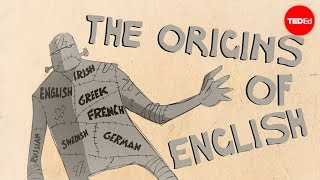(单词翻译:单击)
When we talk about English, we often think of it as a single language
当我们谈到英语,我们常常想到它是一种语言,
but what do the dialects spoken in dozens of countries around the world have in common with each other,
但是那些遍布世界各国不同的方言呢,它们彼此间有什么相似之处,
or with the writings of Chaucer?
或者说和乔叟笔下的诗句有什么相似之处呢?
And how are any of them related to the strange words in Beowulf?
它们和《贝奥武夫》里让人看不懂的单词又有什么共同之处呢?
The answer is that like most languages,
答案就是和大多数语言一样,
English has evolved through generations of speakers, undergoing major changes over time.
英语在数代运用这门语言的人中进化,随着时间的流逝经历了重大的改变。
By undoing these changes, we can trace the language from the present day back to its ancient roots.
为了还原这些变化,我们可以将现代英语追溯到它古老的源头。
While modern English shares many similar words with Latin-derived romance languages, like French and Spanish,
虽然现代英语,和源于拉丁语的罗曼斯语,比如法语和西班牙语,
most of those words were not originally part of it.
有很多单词是相似的。
Instead, they started coming into the language with the Norman invasion of England in 1066.
但是这其中绝大部分的单词起初并不属于英语,而是在1066年诺曼入侵英格兰时才开始变为英语的。
When the French-speaking Normans conquered England and became its ruling class, they brought their speech with them,
当说法语的诺曼人征服英格兰,成为那里的统治阶级时,他们的语言也深深影响了英格兰,
adding a massive amount of French and Latin vocabulary to the English language previously spoken there.
为英格兰当地的本土英语增添了大量法语和拉丁语词汇。
Today, we call that language Old English. This is the language of Beowulf.
现如今,我们称那时的英语为“古英语”。《贝奥武夫》就是用这种古英语写成的。
It probably doesn't look very familiar, but it might be more recognizable if you know some German.
古英语也许让人看起来觉得陌生,但如果你懂一些德语,就会更加容易辨认它了。
That's because Old English belongs to the Germanic language family,
这是因为古英语属于德语的日耳曼语系,
first brought to the British Isles in the 5th and 6th centuries by the Angles, Saxons, and Jutes.
最一开始是在5世纪和6世纪,被盎格鲁人、萨克逊人和朱特人带入不列颠群岛。
The Germanic dialects they spoke would become known as Anglo-Saxon.
他们所讲的日耳曼方言就是我们今天所知道的盎格鲁撒克逊方言。
Viking invaders in the 8th to 11th centuries added more borrowings from Old Norse into the mix.
8世纪到11世纪时的维京入侵者又将更多古诺尔斯语加入到了英语之中。
It may be hard to see the roots of modern English underneath all the words borrowed from French, Latin, Old Norse and other languages.
因为有太多从法语、拉丁语、古诺尔斯语和其他语言中借来的词汇,所以也许很难从中找出现代英语的源头。
But comparative linguistics can help us by focusing on grammatical structure,
但比较语言学可以通过专注于语法结构,
patterns of sound changes, and certain core vocabulary.
声音变化的模式以及某些核心词汇来帮助我们找出源头。
For example, after the 6th century, German words starting with 'p,' systematically shifted to a 'pf' sound
例如说,在6世纪之后,德语中以“p”开头的单词的发音全都系统地转换成了“pf”,
while their Old English counterparts kept the 'p' unchanged.
而与之相对应的古英语却没有发生变化。

In another split, words that have 'sk' sounds in Swedish developed an 'sh' sound in English.
在其他方面,那些具有“sk”发音的瑞典语词汇在英语中变成了“sh”的发音。
There are still some English words with 'sk,' like 'skirt,' and 'skull,'
英语词汇中还是有很多单词具有“sk”发音,比如“裙子”(skirt)和“头骨”(skull),
but they're direct borrowings from Old Norse that came after the 'sk' to 'sh' shift.
但是它们是从古诺尔斯语中直接借鉴来的,这种借鉴发生的时间在从“sk”到“sh”的转换之后。
These examples show us that just as the various Romance languages descended from Latin, English, Swedish, German,
这些例子告诉我们,正如很多罗曼斯语言来源于拉丁语、英语、瑞典语、德语
and many other languages descended from their own common ancestor known as Proto-Germanic spoken around 500 B.C.E.
以及很多其他语言都来源于它们共同的祖先“古日耳曼语”,这种语言在公元前500年被广泛使用。
Because this historical language was never written down,
由于这种历史古老的语言从未被转化成文字,
we can only reconstruct it by comparing its descendants, which is possible thanks to the consistency of the changes.
我们只能通过比较它的衍生语言来重建它,而这可能要归功于这些衍生语言变化的一致性。
We can even use the same process to go back one step further,
我们甚至可以用同样的办法再往前跨一步,
and trace the origins of Proto-Germanic to a language called Proto-Indo-European,
追溯到古日耳曼语来源于古印欧语,
spoken about 6000 years ago on the Pontic steppe in modern day Ukraine and Russia.
这种古印欧语来自6000年前的东欧大草原,也就是今天的乌克兰和俄罗斯地区。
This is the reconstructed ancestor of the Indo-European family
这就是重建的印欧语系的祖先,
that includes nearly all languages historically spoken in Europe, as well as large parts of Southern and Western Asia.
囊括了历史上欧洲以及西南亚很大一部分地区所出现的所有语言。
And though it requires a bit more work,
尽管需要多费点儿功夫,
we can find the same systematic similarities, or correspondences, between related words in different Indo-European branches.
我们仍从不同的印欧语系分支里有关联的词汇中找到系统的相似或者一致之处。
Comparing English with Latin, we see that English has 't' where Latin has 'd',
如果将英语和拉丁语相比较,我们会发现拉丁语中以“d”开头的单词,英语却以“t”开头,
and 'f' where latin has 'p' at the start of words.
拉丁语中以“p”开头的单词,在英语中却变成了“f”。
Some of English's more distant relatives include Hindi, Persian and the Celtic languages it displaced in what is now Britain.
而有些英语的“远亲”,包括北印度语、波斯语以及波斯语,则被转换成了现在的大不列颠英语。
Proto-Indo-European itself descended from an even more ancient language,
古印欧语本身源于一种深知更加古老的语言,
but unfortunately, this is as far back as historical and archeological evidence will allow us to go.
不幸的是,这种语言实在太古老,目前还没有历史和考古学证据能让我们了解它。
Many mysteries remain just out of reach,
很多谜团都还无法被解开,
such as whether there might be a link between Indo-European and other major language families,
比如印欧语系及其他语系会不会
and the nature of the languages spoken in Europe prior to its arrival.
与在先于它们出现在欧洲的语言特性有某种关联,
But the amazing fact remains that nearly 3 billion people around the world,
但这仍然改变不了一个令人不可思议的事实,那就是全世界近30亿人。
many of whom cannot understand each other, are nevertheless speaking the same words shaped by 6000 years of history.
尽管他们中的一些人听不懂彼此所说的语言,但他们却说着历经6000年历史淬炼的相同的词汇。


